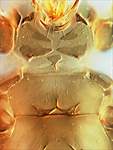Generic diagnosis
Small macropterous or apterous Idolothripinae. Head a little longer than wide; eyes small, directed forwards and smaller ventrally than dorsally; genae converging to posterior with no stout setae; maxillary stylets retracted to postocular setae, close together medially. Antennae 8-segmented, III with 2 sense cones, IV with 3. Pronotum without sculpture, notopleural sutures complete; anteromarginal setae smaller than the other 4 pairs of major setae. Prosternal basantra present but weak; mesopresternum eroded, almost absent; metathoracic sternopleural sutures present. Metanotum with little or no sculpture. Fore tarsal tooth present in male, absent in female. Fore wing with about 6 duplicated cilia. Pelta extending widely across anterior margin of tergite II; tergites III–VI of macropterae each with one pair of large sigmoid wing-retaining setae; tergite IX setae S1 and S2 long in both sexes, but shorter than tube; tube shorter than head.
Nomenclatural data
Cryptothrips Uzel, 1895: 228. Type species Cryptothrips lata Uzel (= nigripes Reuter), by subsequent designation, Hood, 1916: 64.
This is a poorly defined genus in which 12 species are currently listed from various parts of the world (ThripsWiki, 2022).
Australian species
Cryptothrips amneius Mound, 1974: 42.
Relationship data
This genus is a member of the Idolothripinae, Pygothripini, Pygothripina (Mound & Palmer 1983), but the only Australian species placed in Cryptothrips is probably not closely related to the type-species and other northern hemisphere members of the genus, despite sharing the unusual character state of 3 sense cones on antennal segment IV. An undescribed species has been studied that is closely similar in structure to amneius but with 4 sense cones on segment IV, as in Priesneriana, although the basal stem of antennal segment III is sharply flared forming a ring-like ridge.
Distribution data
The only Australian species listed in this genus was described from Port Moresby, Papua New Guinea, but has been seen from various localities between Perth, Brisbane and Canberra.
Biological data
The single species listed from Australia is associate with dead Eucalyptus branches, on which it presumably is spore-feeding.
References
Mound LA (1974) Spore-feeding Thrips (Phlaeothripidae) from Leaf Litter and Dead Wood in Australia. Australian Journal of Zoology 27: 1–106.
Mound LA & Palmer JM (1983) The generic and tribal classification of spore-feeding Thysanoptera (Phlaeothripidae: Idolothripinae). Bulletin of the British Museum (Natural History) Entomology 46: 1–174.
ThripsWiki (2022) ThripsWiki - providing information on the World's thrips. Available from: http://thrips.info/wiki/ (Accessed 15.iii.2022)



